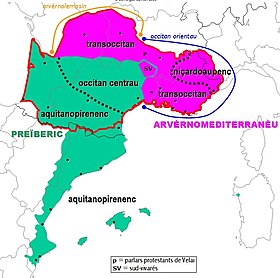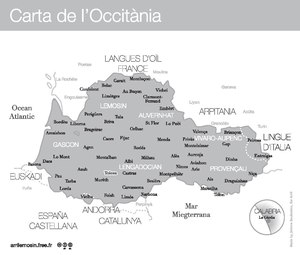Occitano-Romance languages
The Occitan-Romance or Occitan-Romance languages are Occitan and Catalan/Valencian, two very close Romance languages that form a transitional dialect continuum between the Gallo-Romance languages, the Gallo-Italic languages, and the Ibero-Romance languages. A Sometimes Aragonese is included.
Some sources classify both among the Gallo-Romance languages, others, such as Ethnologue, within the Ibero-Romance group and, traditionally, Catalan as Ibero-Romance and Occitan as Gallo-Romance. However, in their written form, modern Catalan and modern Occitan are highly intelligible, and with a percentage of shared lexicon higher than that between Spanish and Portuguese. Some Occitan linguists and philologists have even tried to include Catalan as part of the Occitan diasystem, since the Occitan linguists Pierre Bec and Domergue Sumien classified Catalan as an Occitan variant of the Aquitaine-Pyrenean type. In fact, there are well-founded reasons to consider the Occitan-Romance languages a valid phylogenetic group.
Classification
The term Ibero-Oriental group is a label used by Ethnologue for the classification of Romance languages. According to the available evidence, the Ibero-Oriental group is not discussed, unlike other higher-level groupings used by Ethnologue.
Ethnologue proposes the following hierarchical classification for the iberorromance group:
- Indoeuropeo Itálico /2005 GrupoRomance Romance Romance Languages Ite-Western romances Grupo Ítalo-Occidental - Subgroup Occidental Grupo Galo-Ibérico Grupo Ibero-Romance.
The varieties of Catalan and Occitan together clearly form a phylogenetic group. There is some discussion as to whether these languages together with others form a broader phylogenetic group within the Romance languages. Some authors somewhat arbitrarily classify the Occitano-Romance languages as either a part of the Ibero-Romance languages or a part of the Gallo-Romance languages, although some of the features shared with these groups could be due to later influences or parallel developments.
The existence of numerous common features between the three languages has been pointed out, so it could possibly be spoken of a Pyrenean Romance group made up of Occitan, Catalan and Aragonese.
Internal sorting
Ethnologue divides Ibero-Romance languages into two groups: an Eastern group and a Western group. The internal classification for the Ibero-Oriental group basically coincides with the Occitan-Romance group. Nuclear Occitano-Romance would be made up of the following varieties of Occitan, Catalan/Valencian and Aragonese:
- Occitan
- North West: Auvernés, Limosín, Vivaroalpino
- Southeast West: Lengadocián, Provenzal
- Southwest or Gascon: Aranés, Bearnés, Bigorrés
- Shuadit or Judeoprovenzal (†)
- Catalan-valenciano-balear
- Eastern Variant: Central Catalan, North-East Catalan, Alguerés, Balear: (Mallorquín, Menorquín, Ibicenco).
- Western Variant: North-West Catalan, Leridano, Valencian transition, Valencian: (central or Apitxat, Northern Valencian, Southern Valencian, Alicantino).
- Judeocatalán (†)
- Aragonese: the position of this language is less clear than the other two, but it is clear that it shares an important number of isogloses with the Catalan and the West, not present in the Iberian languages. However, the Aragonese as a whole has undergone major restructurings in the last centuries that have made it noticeably closer to the Iberian-Roman languages, obscuring some of the most clearly western features. The bridge between the west and the iberorromances could be considered, although the origin is clearly occitanorromance.
Supradialectal classification of Occitano-Romance
The Occitan authors Pèire Bec and Domergue Sumien had described a supradialectal classification of Occitano-Romance, dividing it into two groups (Aquitano-Pyrenean and Auverno-Mediterranean) according to some phonetic or grammatical features.
- Auvernomediterráneo Group
- Auvernés
- Limosín
- Vivaroalpino
- Provenzal
- Anatanopirinary group
- Lengadocián
- Central lengadocián
- Southern lengadocián
- Gascon (including the aranes)
- Catalan/Valenciano
- Lengadocián
Linguistic features
Similarities between Catalan/Valencian, Occitan and Aragonese
- Both the Occitan varieties and the Catalan varieties present apocope of the final Latin vowels - worship, worship (protorromance - Hey.). Without emblazoning the Aragone usually presents apocope of the -e but not of the -o, which varies in each dialect.
- lat. TRNCENCIAM Catalan and Occitan tronc [t luminous flux(k)] (against Spanish and Italian trunk and the French tronc)
- lat. L LGNOSḳM Catalan-valencian filled [ s ] ] ] ] ] ] ] ] ] ] ] ] ] ] ] ] ] ] ] ] ] ] ] ] ] ] ] ] ] ] ] ] ] ] ] ] ] ] ] and West lenhós [le]us] (against Spanish) woody and the French ligneux)
- The previous evolution is not given when the - Hey. gives rise to final consonant groups:
- ÁRBORUND cat. Anger, occ. Anger (against Spanish) tree and the French Anger)
- QUATTUOR QUATRO cat. quatre, occ. quatreAra. quatre (four in Spanish and quatre in French)
Both preserve traces of the evolution of the Romance phoneme /*č/ > /ʦ/ > /ʣ/: Latin DĔCE(M) 'ten' > Proto-Romance *dɛče > Catalan -tze/-ze (catorze, quinze, setze 14, 15, 16) and Occitan détz, alternating with /z/ *deʣena 'tens' > Catalan/Occitan /dezena/.
- A large part of the lexicon is common, and in general in the Catalan and western written form they have a very high intelligibility, similar to that between Portuguese and Spanish. There are also notable lexical coincidences between Catalan/valencian, West and Aragonese:
- Latin VÉC(U)LA cat. vella, occ. vielhaArag. viella.
- Latin MEDIU(M) cat. mig, occ. miegArag. Me.
- Latin EGκ 한 *E cat. ♪, occ. Ieu ~ joArag. Me.
- Latin SEQU giftRE *SEGIRE cat.to continue, occ. siegere ~ followArag. continue(e)
- Latin FшLIA(M) cat. fulla, occ. fuòlha ~ fuèlhaArag. Waslla~folla
Differences between Catalan/Valencian and Occitan
Most of the differences in the vowel system come from neutralizations that took place in the unstressed vowel system. In both languages, in a stressed syllable there is a greater number of possible different vowels, while in an unstressed syllable, phonologically different vowels end up articulating in the same way. Although this characteristic is common to both languages, the details of the neutralization differ remarkably. In Occitan the form of neutralization depends on whether a vowel is pretonic or postonic (a /ɔ/ is articulated as [u] in pretonic position and as [o] in postonic position, and as [ɔ] only in tonic position), while that in Catalan the neutralization is the same regardless of the position of the unstressed syllable (although it differs from dialect to dialect). Many of these changes occurred as late as the 13th or 14th century.
Slightly older are the palatalizations that Occitan and Catalan present before palatal or velar consonants:
| Occitan | Catalan/Valenciano | Spanish |
|---|---|---|
| vielha | vella | Old |
| mieg | mig | medium |
| ieu/jo | ♪ | Me. |
| to continue | to continue | to continue |
| fuèlha | fulla | leaf |
Lexical comparison
The numerals in different Occitan-Romance varieties are:
GLOSA North West Occitano occ. East West Catalan/Valenciano Aragonés PROTO-
OcRmAuvergnat Lemosin Gascon Languedoc Provençal Eastern Variant Western Variant '1' vyn / vyn /
vun / vunå/ / yn /
One / Oneand/or me
One / ua/ / yno
One / Oneyno
One / Onea / a
One / OneOne/ One / One
a~one / a
One. / One♪ a ♪ '2' dua
dou / Duasdua
Two. / doasdys / dyos
dus / Duasduos / duos
Two. / doasduas
dous / douas2 / duθ
Two. / duesTwo. Two. / dues
2 / duas
Two. / Duas♪dos~dus ♪
♪'3' t tei
treitrei
Three.Three.
Three.Three.
Three.teses
Three.tr
Three.tr
Three.t
Three.♪ three '4' kat ka
catrekatre
quatrekwat
quatekatre
quatrekat ka
quatrekwatr
quatrekwatre quatre
kwatro~kwatre
quatro / quatre*kwatre '5' ・in
without・in
cincsync
cinqsync
cinqsigil
cinqsigilk
cincsigilk
cincθiŭko~θiŭk
5 / cinc*sigilk '6' ・ei
Yes.・iei
Yeah.ARIAeis
sheissi
YesYes.
Yeah.Yeah.
Yeah.Yeah. Yeah.
6~sieis
Six / six♪ '7' ♪
I know.MINE
sèts
sèts
sèts
sèts
sets
setsiet~s transformationt
siet / set* '8' vø
veujee
uèchweit
ueite
uèchvee
vuevulit / vuit
vuitvuit / wit vuit / huit
weito~weit
ueito / ueit*weit '9' niø~nou
nieu~No.nuu
Nonau
naunuu
Nonu
Nonuu
No.nuu
No.nweu~nuu
nueu / nou♪ '10' die~de
Dié~♪♪
detzd
dètzd
dètsd
dèsd
deud
deudieθ~deu
Ten / deu*d transformationʦ
The numerals '1' and '2' distinguish between masculine and feminine forms.
Contenido relacionado
Η
Aramaic languages
Japanese

